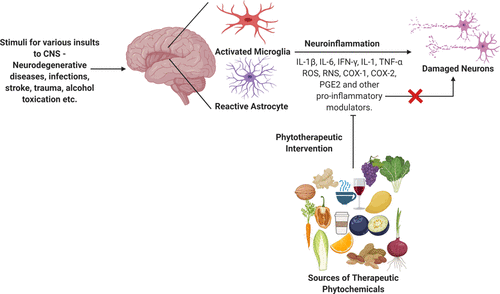当前位置:
X-MOL 学术
›
ACS Chem. Neurosci.
›
论文详情
Our official English website, www.x-mol.net, welcomes your feedback! (Note: you will need to create a separate account there.)
Neuroinflammation Mechanisms and Phytotherapeutic Intervention: A Systematic Review
ACS Chemical Neuroscience ( IF 5 ) Pub Date : 2020-11-04 , DOI: 10.1021/acschemneuro.0c00427 Navrinder Kaur 1, 2 , Heerak Chugh 1 , Meena K Sakharkar 3 , Uma Dhawan 4 , Saravana Babu Chidambaram 5, 6 , Ramesh Chandra 1, 2
ACS Chemical Neuroscience ( IF 5 ) Pub Date : 2020-11-04 , DOI: 10.1021/acschemneuro.0c00427 Navrinder Kaur 1, 2 , Heerak Chugh 1 , Meena K Sakharkar 3 , Uma Dhawan 4 , Saravana Babu Chidambaram 5, 6 , Ramesh Chandra 1, 2
Affiliation

|
Neuroinflammation is indicated in the pathogenesis of several acute and chronic neurological disorders. Acute lesions in the brain parenchyma induce intense and highly complex neuroinflammatory reactions with similar mechanisms among various disease prototypes. Microglial cells in the CNS sense tissue damage and initiate inflammatory responses. The cellular and humoral constituents of the neuroinflammatory reaction to brain injury contribute significantly to secondary brain damage and neurodegeneration. Inflammatory cascades such as proinflammatory cytokines from invading leukocytes and direct cell-mediated cytotoxicity between lymphocytes and neurons are known to cause “collateral damage” in models of acute brain injury. In addition to degeneration and neuronal cell loss, there are secondary inflammatory mechanisms that modulate neuronal activity and affect neuroinflammation which can even be detected at the behavioral level. Hence, several of health conditions result from these pathogenetic conditions which are underlined by progressive neuronal function loss due to chronic inflammation and oxidative stress. In the first part of this Review, we discuss critical neuroinflammatory mediators and their pathways in detail. In the second part, we review the phytochemicals which are considered as potential therapeutic molecules for treating neurodegenerative diseases with an inflammatory component.
中文翻译:

神经炎症机制和植物治疗干预:系统评价。
在几种急性和慢性神经系统疾病的发病机理中都表明了神经炎症。脑实质中的急性病灶会在各种疾病原型中以相似的机制诱发强烈而高度复杂的神经炎症反应。中枢神经系统中的小胶质细胞感知组织损伤并引发炎症反应。对脑损伤的神经炎性反应的细胞和体液成分对继发性脑损伤和神经退行性变起重要作用。在急性脑损伤模型中,炎症级联反应(例如来自入侵白细胞的促炎细胞因子以及淋巴细胞与神经元之间直接的细胞介导的细胞毒性)会导致“附带损害”。除了变性和神经元细胞丢失,存在调节神经元活动并影响神经发炎的继发性炎症机制,甚至可以在行为水平上检测到。因此,由这些致病条件导致几种健康状况,这些疾病由慢性炎症和氧化应激引起的进行性神经元功能丧失所强调。在本综述的第一部分中,我们详细讨论了关键的神经炎症介质及其途径。在第二部分中,我们回顾了植物化学物质,这些植物化学物质被认为是治疗具有炎症成分的神经退行性疾病的潜在治疗分子。这些致病性疾病导致几种健康状况,这些疾病是由慢性炎症和氧化应激引起的渐进性神经元功能丧失引起的。在本综述的第一部分中,我们详细讨论了关键的神经炎症介质及其途径。在第二部分中,我们回顾了植物化学物质,这些植物化学物质被认为是治疗具有炎症成分的神经退行性疾病的潜在治疗分子。这些致病性疾病导致几种健康状况,这些疾病是由慢性炎症和氧化应激引起的渐进性神经元功能丧失引起的。在本综述的第一部分中,我们详细讨论了关键的神经炎症介质及其途径。在第二部分中,我们回顾了植物化学物质,这些植物化学物质被认为是治疗具有炎症成分的神经退行性疾病的潜在治疗分子。
更新日期:2020-11-18
中文翻译:

神经炎症机制和植物治疗干预:系统评价。
在几种急性和慢性神经系统疾病的发病机理中都表明了神经炎症。脑实质中的急性病灶会在各种疾病原型中以相似的机制诱发强烈而高度复杂的神经炎症反应。中枢神经系统中的小胶质细胞感知组织损伤并引发炎症反应。对脑损伤的神经炎性反应的细胞和体液成分对继发性脑损伤和神经退行性变起重要作用。在急性脑损伤模型中,炎症级联反应(例如来自入侵白细胞的促炎细胞因子以及淋巴细胞与神经元之间直接的细胞介导的细胞毒性)会导致“附带损害”。除了变性和神经元细胞丢失,存在调节神经元活动并影响神经发炎的继发性炎症机制,甚至可以在行为水平上检测到。因此,由这些致病条件导致几种健康状况,这些疾病由慢性炎症和氧化应激引起的进行性神经元功能丧失所强调。在本综述的第一部分中,我们详细讨论了关键的神经炎症介质及其途径。在第二部分中,我们回顾了植物化学物质,这些植物化学物质被认为是治疗具有炎症成分的神经退行性疾病的潜在治疗分子。这些致病性疾病导致几种健康状况,这些疾病是由慢性炎症和氧化应激引起的渐进性神经元功能丧失引起的。在本综述的第一部分中,我们详细讨论了关键的神经炎症介质及其途径。在第二部分中,我们回顾了植物化学物质,这些植物化学物质被认为是治疗具有炎症成分的神经退行性疾病的潜在治疗分子。这些致病性疾病导致几种健康状况,这些疾病是由慢性炎症和氧化应激引起的渐进性神经元功能丧失引起的。在本综述的第一部分中,我们详细讨论了关键的神经炎症介质及其途径。在第二部分中,我们回顾了植物化学物质,这些植物化学物质被认为是治疗具有炎症成分的神经退行性疾病的潜在治疗分子。

























 京公网安备 11010802027423号
京公网安备 11010802027423号